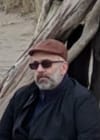I stumbled upon this 2024 study on aphantasia, v23ab, and the right hippocampus:

Aphantasia is a condition in which the sufferer reports an inability to to form mental pictures, aka visualizations. The main finding was that aphantasia patients had lower functional connectivity between the right hippocampus and cortical area v23ab.
Temporal lobe epilepsy (TLE) is a condition in which sufferers experience seizures. These seizures are generally associated with the hippocampus, one of the topological "poles" of the cerebral cortex. They often report these seizures as ecstatic experiences, followed by a clarity of mind and a sense of awe and sacredness.
Neurologist Norman Geschwind described a personality pattern that he discerned in various TLE patients under his care, which became known as Geschwind's syndrome. It is suggested that many spiritual leaders throughout history have had this condition.
The right and left hippocampus are thought to be somewhat specialized for spatial and verbal/temporal memory. In our neuromythographic model, the right hippocampus is Akasha, the Hindu personification of space, and the left hippocampus is Kala, the Hindu personification of time.
Researchers Dr. Michael Persinger and Stanley Koren are known for inventing the God Helmet--a device that can stimulate spiritual sensations by targeting certain areas of the brain with magnetic stimulation. The God Helmet has periodically captured the public imagination.
Jiddhu Krishnamurti, the well-known Indian spiritualist, described a recurring phenomenon he called "the process". The process usually started with a headache, and proceeded to shaking, and ended with a spiritual state in which he became more aware of "the otherness"--which may be interpreted as a spiritual presence that was not himself. In a conversation with physicist David Bohm, Krishnamurti described his own impairment in forming mental images, suggesting aphantasia.
We may conjecture here that Krishnamurti suffered from temporal lobe epilepsy. The resulting impairment--an inability to visualize space and spacetime--may have been the source of his superpower--the experience of timelessness, a place outside of space and time.
Geschwind's syndrome has a list of five criteria:
- hypergraphia: a compulsion to write. Krishnamurti was a prolific writer. Dostoevsky, the famous Russian author of War and Peace, was a TLE sufferer, who described similar symptoms to Krishnamurti.
- hyperreligiosity: an unusual interest in religious and philosophical matters. Krishnamurti was surely interested in these things.
- atypical sexuality: usually this manifests as a lack of sex drive. The testimony of women who had relationships with Krishnamurti suggests he had curtailed libido.
- circumstantiality: a tendency to speak at length all around the perimeter of a topic, in highly abstract ways, and repetitively. A review of Krishnamurti's many talks may confirm this.
- intensified inner mental life: surely this describes Krishnamurti
A colleague of Persinger and Koren, Todd Murphy, proposes that there are two types of mystic: right hippocampal and left amygdalar. The left amygdala type is more of a warm, social community builder full of heightened empathy. This interpretation stems from work with the God Helmet.

My speculation is that right hippocampal damage results in the Geschwind syndrome, while left hippocampal damage may result in an undescribed sort of mystic that is less hypergraphic and works more in pictures and visuals--perhaps an artist. Bilateral damage may result in a combination of both.
In any case, our neuromythography myth for the paper at the top of this post is:
In aphantasia, during retrieval of autobiographical visual memories, Akasha (right hippocampus, personification of space) spoke less to Saga (v23ab, Norse goddess of historical storytelling).
These archetypes do well to explain the study's aphantasia findings in intuitive terms.



